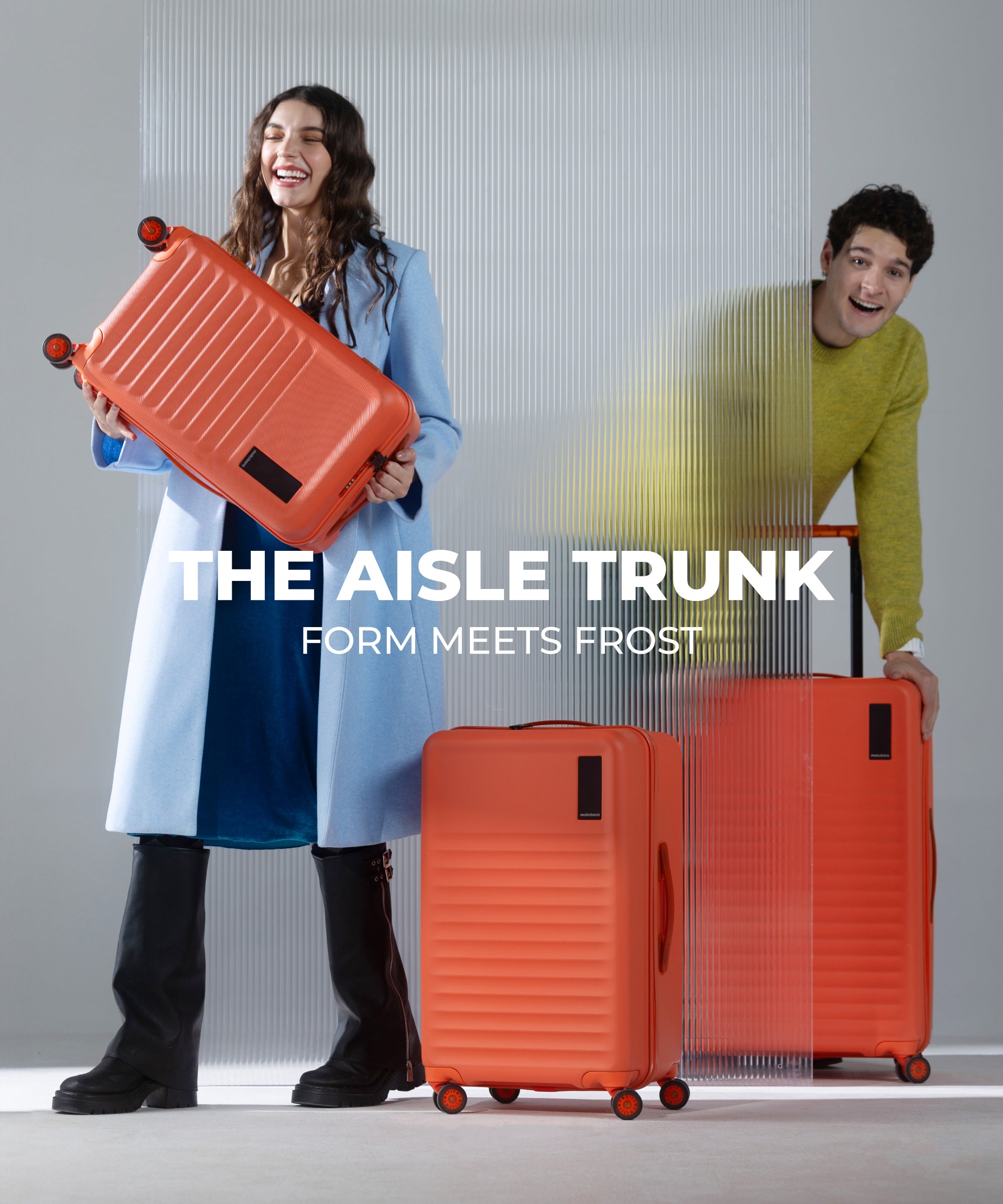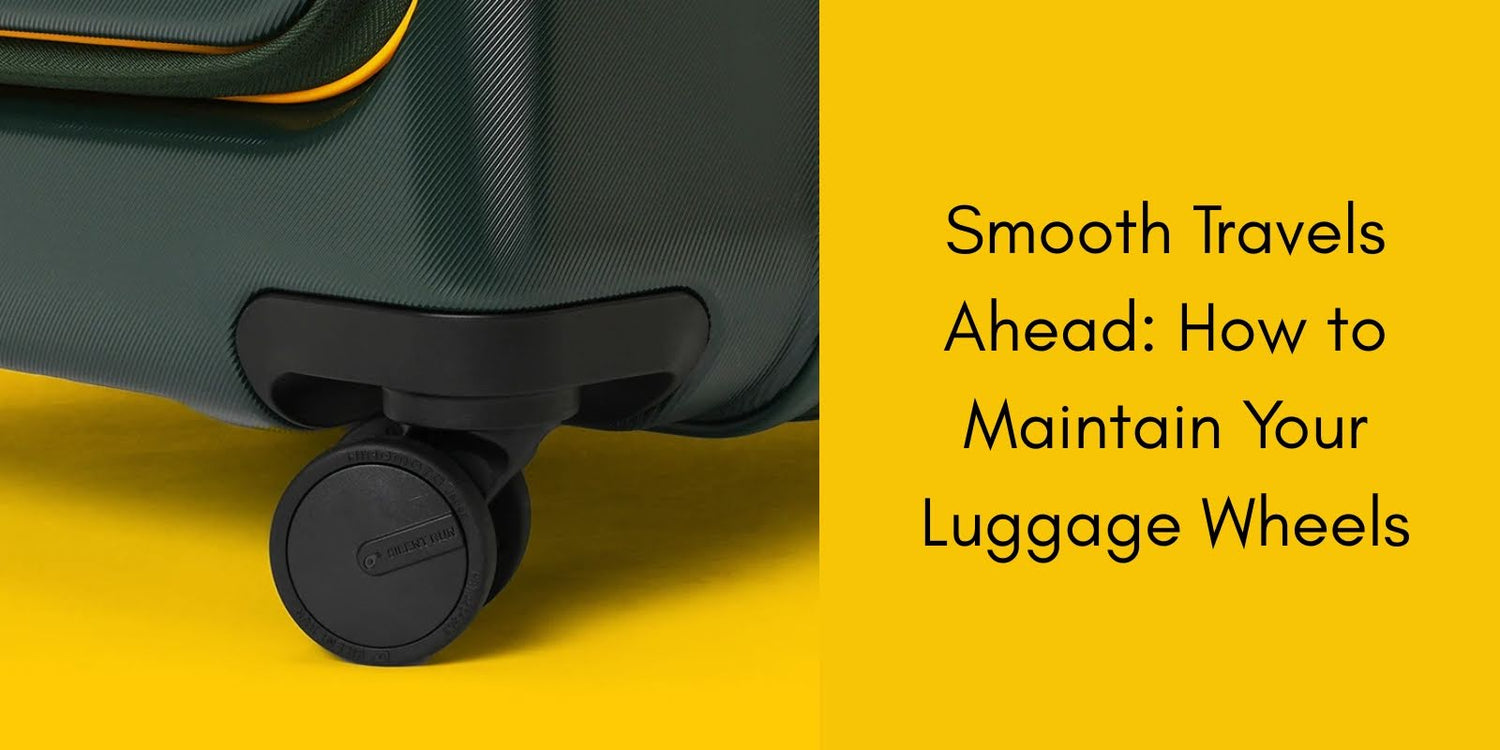TL;DR: Quick Luggage Wheel Maintenance Essentials
- Clean luggage wheels after every trip to prevent debris buildup and maintain smooth rolling performance.
- Lubricate suitcase wheels every 3-6 months using white lithium grease or 3-in-1 oil for optimal function.
- Inspect wheels regularly for loose screws, cracks, or unusual wear patterns to catch problems early.
- Fix luggage wheels immediately when you notice squeaking, grinding, or wobbling to prevent further damage.
- Store luggage upright and avoid extreme temperatures to protect wheel materials and extend lifespan.
- Invest in quality luggage maintenance habits now to save money on expensive airport replacements later.
You know that moment when you're rushing through the airport and one of your luggage wheels starts making that awful grinding sound? Or worse, when it completely jams up, leaving you dragging your bag like a reluctant pet? We get it. Your luggage wheels are the unsung heroes of your travel adventures, and they deserve some TLC.
Think about it. Those small wheels carry everything you need for your journey, rolling across rough airport floors, cobblestone streets, and hotel carpets. Yet most travelers only notice them when something goes wrong. Smart luggage wheel maintenance can save you from travel disasters and keep you moving smoothly toward your destination.
Why Proper Luggage Care Keeps Your Wheels Rolling
Imagine this: You're at the start of your dream vacation, excited about the adventures ahead. Then reality hits. Your suitcase wheels decide to throw a tantrum right at the airport entrance. The wobbly wheel, the stuck spinner, or that grinding noise that makes everyone stare. These aren't just minor inconveniences.
The real cost of neglected wheels goes beyond frustration:
- Travel disruption: A broken wheel can turn a smooth journey into a stressful ordeal.
- Physical strain: Dragging heavy luggage puts unnecessary stress on your back and shoulders.
- Additional expenses: Emergency luggage purchases at airports come with premium price tags.
- Damaged belongings: Poor wheel performance can cause your luggage to tip or fall.
Quality luggage like The Cabin Pro comes with Japanese Hinomoto wheels specifically designed for smooth, silent movement. But even the best wheels need regular care to maintain their performance over the years of travel.
Understanding Different Types of Luggage Wheels
Before diving into maintenance, let's understand what you're working with. Not all wheels are created equal, and knowing your wheel type helps you provide the right care.
Spinner Wheel Luggage vs Traditional Two-Wheel Systems
Spinner wheels (four or eight wheels) allow 360-degree rotation, making your luggage incredibly maneuverable. You can push, pull, or roll it beside you effortlessly. Traditional two-wheel systems, on the other hand, require tilting and pulling behind you.
Spinner advantages:
- Reduced strain on your arm and shoulder
- Better stability when standing upright
- Smoother navigation through tight spaces
Single vs Double Wheels for Luggage Bags
Many premium luggage pieces, including The Transit Cabin Pro, feature double wheel systems. Instead of four single wheels, you get eight smaller wheels working in pairs.
Double wheel benefits:
- Better weight distribution
- Improved stability on uneven surfaces
- Reduced wear on individual wheels
- Smoother rolling experience
Premium Hinomoto Wheels and Quality Indicators
Hinomoto wheels, featured in Mokobara's premium collections, represent the gold standard in luggage mobility. These Japanese-engineered wheels are designed for:
- Silent operation: No more embarrassing squeaks in quiet hotel hallways
- Durability: Built to withstand thousands of miles of travel
- Smooth performance: Glide effortlessly across various surfaces
Daily Maintenance Habits for Travel Bag Wheels
The best luggage maintenance tips are the simple ones you can do regularly. Small, consistent efforts prevent big problems later.
Cleaning Luggage Trolley Wheels After Each Trip
Your wheels pick up everything from airport grime to street debris. This buildup isn't just unsightly. It affects performance and can cause permanent damage.
Essential cleaning steps:
- Remove loose debris: Use a small brush or toothpick to clear hair, thread, and dirt from wheel crevices
- Wipe down surfaces: Use a damp cloth with mild soap to clean wheel exteriors
- Check for damage: Look for cracks, chips, or unusual wear patterns
- Dry thoroughly: Prevent rust by ensuring wheels are completely dry before storage
Pro tip: Keep a small cleaning kit in your travel bag. A toothbrush, wet wipes, and a small screwdriver can handle most wheel issues on the go.
Regular Inspection for Rolling Suitcase Performance
Your wheels communicate with you. You just need to know their language. Regular inspection helps catch problems before they become travel disasters.
Weekly wheel check routine:
- Spin test: Each wheel should rotate freely without resistance.
- Alignment check: Wheels should track straight when rolling.
- Noise assessment: Listen for grinding, squeaking, or clicking sounds.
- Visual inspection: Look for loose screws, cracks, or uneven wear
Lubrication Techniques for Suitcase Roller Wheels
Just like your car needs oil changes, your suitcase roller wheelsneed occasional lubrication to maintain smooth operation. This simple maintenance step can extend wheel life significantly.
Best Lubricants for Luggage Roller Wheels
Recommended lubricants:
|
Lubricant Type |
Best For |
Application Method |
Frequency |
|
White lithium grease |
Heavy-duty wheels |
Apply to bearings |
Every 6 months |
|
3-in-1 oil |
Standard wheels |
Drop into pivot points |
Every 3 months |
|
Silicone spray |
All wheel types |
Light coating |
Monthly for frequent travelers |
Note: Avoid WD-40 for regular maintenance. It's better for cleaning than long-term lubrication.
Step-by-Step Lubrication Process
For spinner wheels:
- Remove visible debris from wheel housing
- Apply lubricant to the central bearing point
- Spin wheel multiple times to distribute lubricant
- Wipe excess to prevent dirt attraction
- Test smoothness by rolling luggage
Frequency Guidelines for Different Travel Patterns
Your lubrication schedule should match your travel intensity:
- Frequent travelers (monthly trips): Monthly lubrication
- Regular travelers (quarterly trips): Every 3 months
- Occasional travelers (annual trips): Every 6 months
- Heavy luggage users: More frequent care needed
When to Repair Luggage Wheels vs Replace
Knowing when to fix luggage wheelsversus buying new ones can save money and extend your luggage life. Sometimes a simple repair is all you need.
Common Signs Your Wheels Need Attention
Immediate attention required:
- Grinding noises during rolling
- Wheels that don't spin freely
- Visible cracks in wheel material
- Loose or wobbly wheel movement
- Uneven wear patterns on wheel surfaces
Emergency fixes for travel:
- Loose screws: Tighten with a small screwdriver
- Stuck wheels: Clean debris and apply emergency lubrication
- Wobbly wheels: Check and tighten mounting hardware
DIY Luggage Wheel Repair Techniques
Many wheel problems are surprisingly easy to fix with basic tools and patience.
Basic repair kit:
- Small screwdrivers (Phillips and flathead)
- Needle-nose pliers
- Lubricating oil
- Replacement screws
- Cleaning materials
Common repairs you can handle:
- Tightening loose wheels: Usually just requires a screwdriver
- Cleaning jammed wheels: Remove debris and lubricate
- Replacing worn wheel housings: More complex but doable with patience
Complete Luggage Wheel Replacement Guide
Sometimes repair isn't enough, and you need full luggage wheel replacement. This might sound intimidating, but it's often more straightforward than you'd expect.
Finding the Right Suitcase Wheel Replacement Parts
Key measurements for replacement:
- Wheel diameter and width
- Mounting hole spacing
- Axle diameter
- Weight capacity requirements
Where to source replacement wheels:
- Manufacturer websites
- Luggage repair shops
- Online marketplaces with universal options
- Specialty travel accessory stores
Tools Needed for Wheel Installation
Essential tools:
- Screwdriver set
- Pliers
- Measuring tape
- Work surface
- Good lighting
Installation process:
- Remove damaged wheel by unscrewing mounting hardware
- Clean mounting area of debris and old lubricant
- Test fit new wheel before final installation
- Secure with appropriate hardware
- Test wheel movement before use
Choosing the Best Luggage Wheels for Durability
When replacement becomes necessary, choosing quality wheels makes a significant difference in longevity and performance.
Material Comparison: Rubber vs Polyurethane
Rubber wheels:
- Pros: Quiet operation, good shock absorption
- Cons: Wear faster, can leave marks on floors
- Best for: Indoor use, lightweight luggage
Polyurethane wheels:
- Pros: Exceptional durability, floor-friendly, smooth rolling
- Cons: Slightly more expensive
- Best for: Heavy luggage, frequent travel
Wheel Size Impact on Performance
Larger wheels (3+ inches):
- Roll more easily over obstacles
- Better for outdoor surfaces
- Handle weight better
Smaller wheels (2 inches or less):
- More compact storage
- Better for indoor surfaces
- Lighter overall weight
Best Suitcase Wheels for Different Travel Types
Business travel: Silent-running wheels like those on The Em Cabin Pro for hotel environments
Adventure travel: Durable, large-diameter wheels for rough surfaces
Family travel: Heavy-duty wheels that can handle extra weight
Protecting Your 4 Wheel Luggage Investment
Your luggage is an investment in stress-free travel. Proper protection strategies can significantly extend wheel life and maintain performance.
Storage Tips to Prevent Wheel Damage
Proper storage prevents many wheel problems:
- Store upright when possible to avoid wheel deformation.
- Use dust covers to prevent debris accumulation.
- Avoid extreme temperatures that can affect wheel materials.
- Keep in dry areas to prevent rust and deterioration.
Storage checklist:
- Clean wheels before storage
- Apply light lubrication
- Store in stable, upright position
- Check periodically for pest damage
Airport Handling Precautions
Minimize rough handling damage:
- Use hard-shell luggage like The Transit Wave series for better wheel protection.
- Avoid overpacking to reduce stress on wheel mounts.
- Consider luggage locks to prevent unauthorized opening and wheel damage.
- Remove luggage promptly from the baggage claim to minimize handling.
Climate Considerations for Wheel Longevity
Different climates affect wheel materials differently:
Hot climates:
- Can soften plastic wheels temporarily
- May accelerate rubber degradation
- Require more frequent lubrication
Cold climates:
- Can make materials brittle
- May cause temporary stiffness
- Need gentle warming before use
Humid environments:
- Increase rust risk for metal components
- May promote debris accumulation
- Require more frequent cleaning
Troubleshooting Common Wheel Problems
Even with the best care, wheels sometimes develop issues. Here's how to diagnose and fix luggage wheels when problems arise.
Fixing Stuck or Jammed Wheels
Diagnosis steps:
- Identify the source - debris, damage, or wear?
- Check for foreign objects wound around the wheel
- Test wheel movement after cleaning
- Apply appropriate lubrication
Solutions by problem type:
- Hair/thread wrapped wheels: Carefully cut away with small scissors
- Sand/dirt jamming: Flush with water and dry thoroughly
- Bearing issues: May require professional service or replacement
Addressing Uneven Wear Patterns
Common wear patterns and causes:
- Flat spots: Usually from dragging rather than rolling.
- Edge wear: Indicates alignment issues or overloading.
- Uneven side wear: Suggests luggage isn't rolling straight
Prevention strategies:
- Always roll luggage when possible
- Check and maintain proper wheel alignment
- Distribute weight evenly in luggage
- Rotate luggage usage if you have multiple pieces
Noise Reduction Solutions
Types of wheel noise and fixes:
- Squeaking: Usually needs lubrication or debris removal.
- Grinding: Often indicates worn bearings or damaged wheels.
- Clicking: Typically loose hardware that needs tightening.
- Humming: May indicate wheels need cleaning or adjustment.
Professional Luggage Wheel Repair Services
Sometimes DIY repairs aren't enough, and professional help becomes necessary. Knowing when to seek expert assistance can save time and prevent further damage.
When to Seek Professional Help
Professional repair indicators:
- Multiple wheels failing simultaneously
- Complex bearing replacements needed
- Structural damage to wheel mounts
- Warranty considerations for expensive luggage
Cost Comparison: Repair vs New Luggage
Typical repair costs:
- Basic wheel replacement: ₹500-1,500 per wheel
- Professional cleaning and lubrication: ₹200-500
- Complex bearing replacement: ₹800-2,000
When replacement makes sense:
- Repair costs exceed 50% of luggage value
- Multiple major components need replacement
- Luggage is already showing age in other areas
Finding Qualified Repair Technicians
Research tips:
- Check with luggage manufacturers for authorized service centers
- Read online reviews and ratings
- Ask about the warranty on repair work
- Get quotes from multiple providers
Maintaining Small Suitcase Wheels vs Large Cases
Different luggage sizes require adjusted maintenance approaches. Small suitcase with wheels units face different stresses than large check-in bags.
Size-Specific Maintenance Challenges
Cabin-sized luggage challenges:
- Higher frequency of use
- More variable surface contact
- Tighter wheel spacing
- Different weight distribution
Large luggage considerations:
- Greater weight stress on wheels
- Less frequent but more intensive use
- Different storage requirements
- More complex wheel systems
Weight Distribution Considerations
For smaller bags:
- Pack heavier items toward wheels
- Avoid overloading beyond capacity
- Use compression features properly
For larger cases:
- Distribute weight evenly throughout
- Consider internal organization systems
- Use compression straps effectively
Frequency Adjustments for Different Sizes
Maintenance schedule by size:
- Cabin bags: Monthly checks for frequent travelers
- Medium luggage: Quarterly maintenance
- Large check-in bags: After every few trips
Keep Your Journey Rolling Smoothly
Your luggage wheels are your travel companions, working tirelessly to keep you moving toward your next adventure. With proper luggage wheel maintenance, you can avoid travel disruptions and ensure smooth journeys for years to come.
Ready to experience what perfectly maintained wheels feel like? The Cabin Pro and Transit series from Mokobarafeature premium Hinomoto wheels designed for effortless travel. These Japanese-engineered wheels, combined with regular maintenance, will keep you #GoingPlaces without missing a beat.
Take action today: Inspect your luggage wheels, give them the care they deserve, and invest in quality luggage that's built to last. Your future traveling self will thank you for the foresight.
Frequently Asked Questions
Q. How do you maintain luggage wheels for smooth rolling?
Clean wheels after each trip, lubricate every 3-6 months, inspect regularly for damage, and store luggage properly between uses. Regular maintenance prevents most wheel problems.
Q. Can you oil suitcase wheels?
Yes, use appropriate lubricants like white lithium grease or 3-in-1 oil. Apply to wheel bearings and pivot points, but avoid over-lubrication, which attracts dirt.
Q. What are common problems with luggage wheels?
The most frequent issues include squeaking from a lack of lubrication, jamming from debris buildup, wobbling from loose hardware, and uneven wear from improper rolling technique.
Q. How often should you check luggage wheels?
Inspect wheels before each trip and perform thorough maintenance every 3-6 months, depending on usage frequency. Heavy travelers should check monthly.
Q. Can luggage wheels be replaced or repaired?
Most luggage wheelscan be repaired or replaced. Simple issues like loose screws or debris removal are easy DIY fixes, while bearing replacement or complete wheel substitution may require basic tools and patience.
Q. What's the difference between spinner and traditional luggage wheels in terms of maintenance?
Spinner wheelsrequire more frequent cleaning due to their 360-degree rotation mechanism, but they're easier to lubricate. Traditional two-wheel systems need less maintenance but require more careful alignment checks to prevent uneven wear patterns.




Leave a comment
This site is protected by hCaptcha and the hCaptcha Privacy Policy and Terms of Service apply.